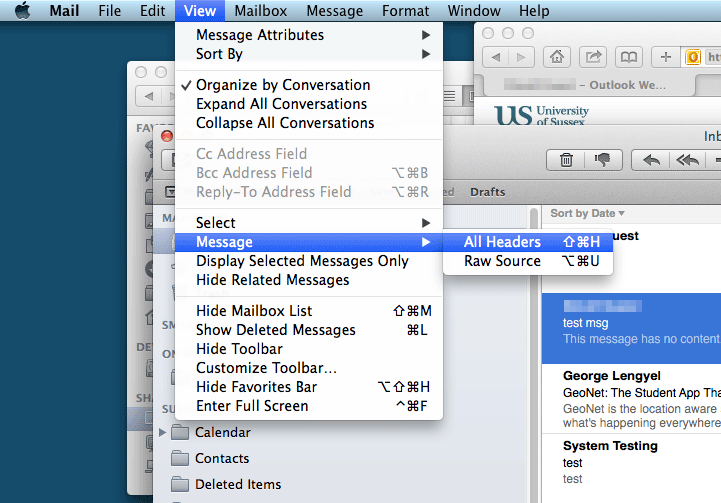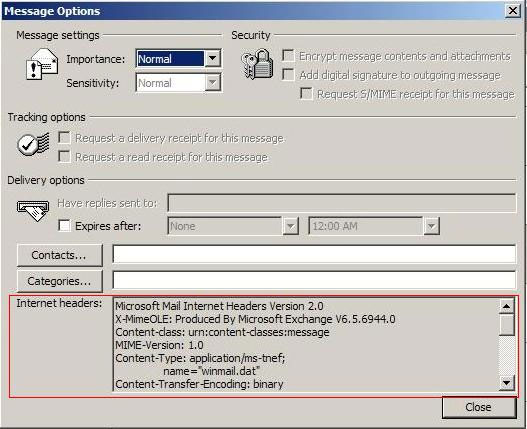
- FIND EMAIL HEADERS IN OUTLOOK 2013 HOW TO
- FIND EMAIL HEADERS IN OUTLOOK 2013 CODE
- FIND EMAIL HEADERS IN OUTLOOK 2013 WINDOWS
This info will be the server who receives the email from the server above.
FIND EMAIL HEADERS IN OUTLOOK 2013 WINDOWS
Read this great article by PowerShell MVP Tome about regular expressions and Windows PowerShell. Luckily, this is where regular expressions come to the rescue. You can see from the preceding screenshot that it has a pattern. We have to extract the piece of information between the above-mentioned sections to form our objects. Let’s talk about Windows PowerShell, starting with another figure. In this example, we have four lines, so we have four hops for the email to reach your mailbox.Įnough of theory. Maybe a server was busy or there was too much load, which could cause delays to email being delivered to your inbox. At times, there might be a delay when going through one of these chains. The hop chain continues until it finally reaches your inbox. Each trip from server to server is called a hop. Now, this server will send the message again to another server and so on. If that did not make much sense, it might help to visualize it like in the following figure. 002” and at time “Wed, 18:50:16 +0800”, which is UTC +8 (which is Singapore), you can tell from the server which received the message it says “” Received the email from Server “ ()” by Server “ ()” with protocol “mapi id. Take a look at the boxes and circles in the image above, and read it like this: You see, it looks already a lot cleaner, after you remove those extra lines. Here is how it looks after removing the unwanted lines:
FIND EMAIL HEADERS IN OUTLOOK 2013 CODE
The above piece of code has only four lines and is cut into different lines. Whenever you try to make sense of an email message header, read it from the bottom up. That is our main focus in today’s post: we want to get this data parsed out of this messy text and present it in a nice little table so that you can understand what really happened with that email message. For an email to come to your inbox, it takes so many routes. This section has information about how this message got to your inbox.
FIND EMAIL HEADERS IN OUTLOOK 2013 HOW TO
RFC 822 tells how to place information about an email message into this header.įor now, focus on the green box in the preceding figure. This text information contains a lot of details about the message you have received. The following figure shows how a message header looks. For example, here are instructions for getting the message header of an email address if you are using Outlook 2010. There are different ways to view this message header, depending on which email client you are using. Every email message you receive in your inbox has this information. By the way, 90 percent of all email is either spam or viruses.Įach and every email message you send or receive has a piece of information in it called a message header. It was estimated that approximately 294 billion messages per day are sent, which is 2.8 million messages per second.

Last year, a survey was conducted to figure out the number of email messages sent every day across the globe. I have developed custom applications in C# for automation. With Windows PowerShell, I automate Exchange/Active Directory tasks, and I am also good at WMI, ADSI, and generating custom reports. Before Windows PowerShell, I did most of my scripting in VBScript. I am an Exchange administrator, and I have been scripting for more than seven years now. I am the founder of the Singapore PowerShell User Group. First, though, let’s learn something about Thiyagu. Thiyagarajan Parthiban is our guest blogger today with an interesting article about using Windows PowerShell to analyze Exchange email.

Summary: Guest Blogger Thiyagu teaches how to use Windows PowerShell to parse and analyze email message headers.


 0 kommentar(er)
0 kommentar(er)
